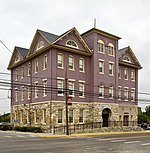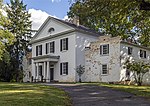Charles Town Cave
Charles Town Cave — also formerly known as Crystal Lake Cave and Lakeland Cave — is located in the center of Charles Town, West Virginia, United States. One entrance was in the cellar of a bakery (since demolished) and led down to a passage about 175 feet long to a large pool of clear water about 25 feet in diameter. Much of the cave is under the current Old Opera House building. The cave was discovered accidentally in 1906 and was for a time developed as a commercial show cave in the late 1920s and early '30s. Water sampling in 1997 showed the presence of petroleum contamination in the water.The cave is closed to the public. Rumors persist about other entrances to the cave in various Charles Town and Ranson buildings.
Excerpt from the Wikipedia article Charles Town Cave (License: CC BY-SA 3.0, Authors).Charles Town Cave
North Samuel Street,
Geographical coordinates (GPS) Address Nearby Places Show on map
Geographical coordinates (GPS)
| Latitude | Longitude |
|---|---|
| N 39.290833333333 ° | E -77.859166666667 ° |
Address
North Samuel Street 255
25414
West Virginia, United States
Open on Google Maps









